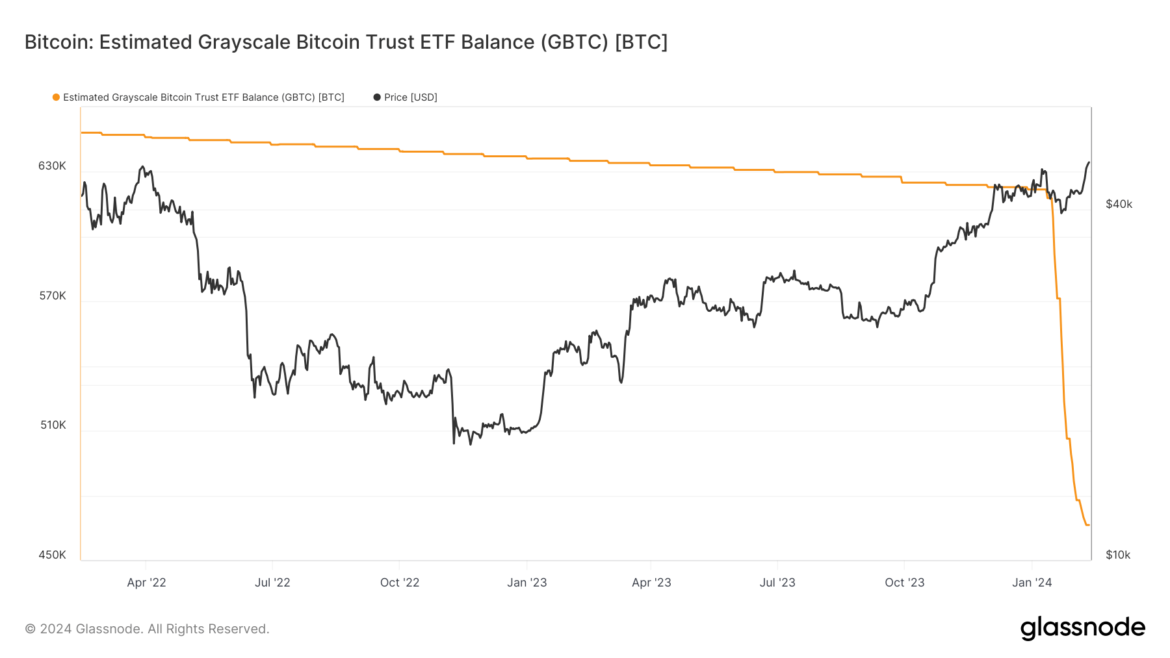 Spot bitcoin exchange-traded funds (ETFs) concluded the week on an upbeat note, securing $203 million in positive inflows on Friday, as per the latest data. Despite an initial setback of $84.7 million in net outflows on April 1, the ETFs have since rebounded, gathering $569.4 million in net inflows. Bitcoin ETFs Overcome Early April Setback […]
Spot bitcoin exchange-traded funds (ETFs) concluded the week on an upbeat note, securing $203 million in positive inflows on Friday, as per the latest data. Despite an initial setback of $84.7 million in net outflows on April 1, the ETFs have since rebounded, gathering $569.4 million in net inflows. Bitcoin ETFs Overcome Early April Setback […]
Source link
inflows
Bitcoin ETFs see $505 million total inflows led by BlackRock as VanEck breaks record
Bitcoin ETF inflows surged on March 11, 2024, with a net gain of $505.5 million, according to data from Bitmex Research. The strong performance was led by BlackRock’s iShares Bitcoin ETF (IBIT), which saw inflows of $562.9 million, representing a 0.12% increase in total assets. Fidelity’s FBTC fund also contributed to the positive momentum, attracting $215.5 million in new investments.
Other notable Newborn Nine ETFs with inflows included Bitwise’s BITB fund ($49.8 million), ARK Invest’s ARKB fund ($13.0 million), and VanEck’s BRRR fund ($118.8 million). VanEck’s announcement to waive fees until 2025 led to its strongest day by far. Previously, the fund had not seen more than $14.2 million in a single day. However, not all Newborn Nine funds experienced gains, with Invesco’s BTCO ETF reporting an outflow of $9.7 million.
Further, Grayscale continued its outflows, with $494 million leaving the fund, the highest level since Feb. 29. Yet, the inflows into Newborn Nine ETFs significantly outweighed the Grayscale outflow for the sixth consecutive day. Only two days since Jan. 26 have total outflows surpassed inflows.
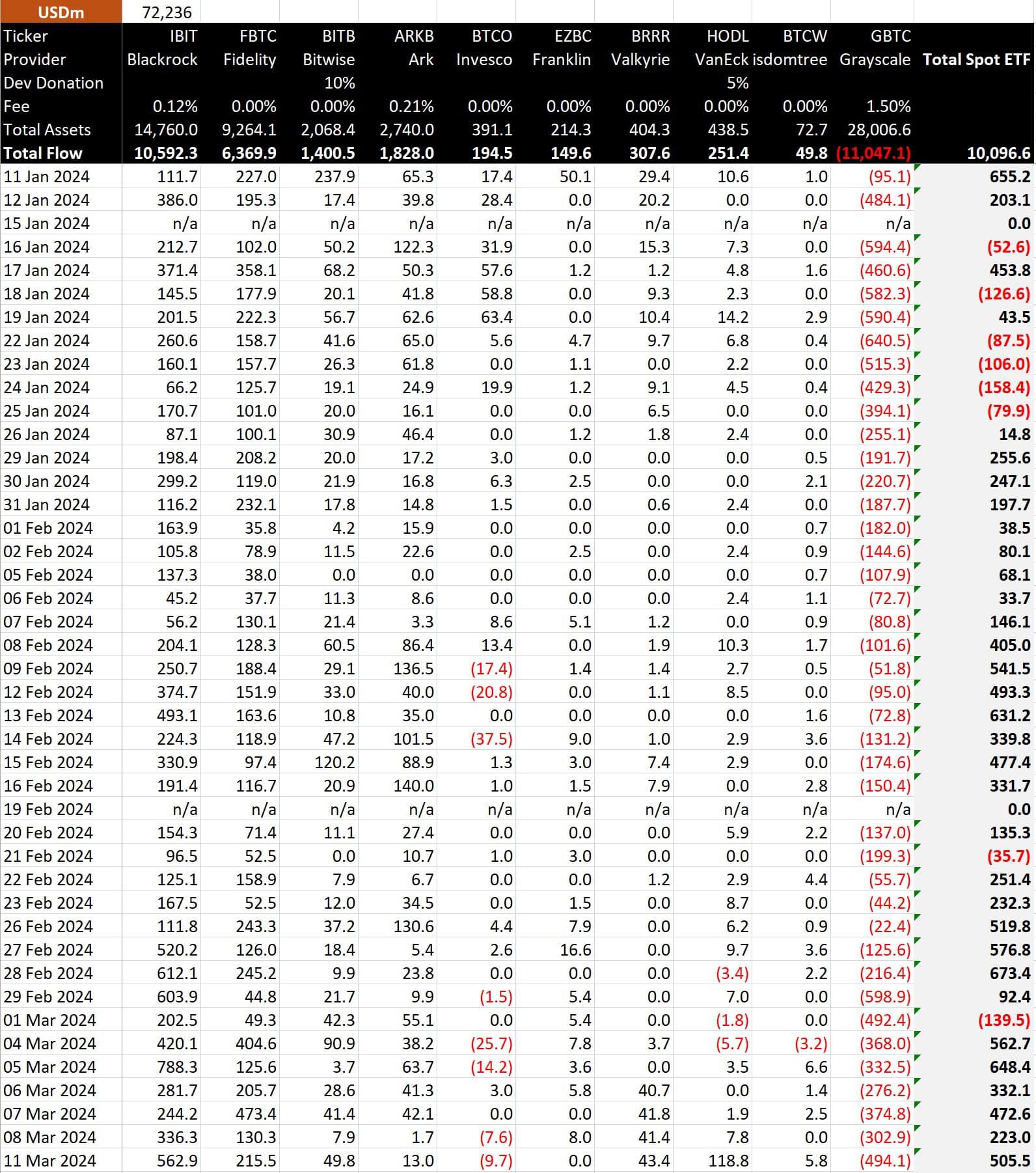
In terms of Bitcoin, the net inflow amounted to 7,009 BTC, with BlackRock’s IBIT fund accounting for 7,805 BTC of the total. Fidelity’s FBTC fund added 2,988 BTC, while Bitwise’s BITB fund saw an inflow of 690 BTC. ARK Invest’s ARKB fund and VanEck’s BRRR fund gained 180 BTC and 1,648 BTC, respectively.
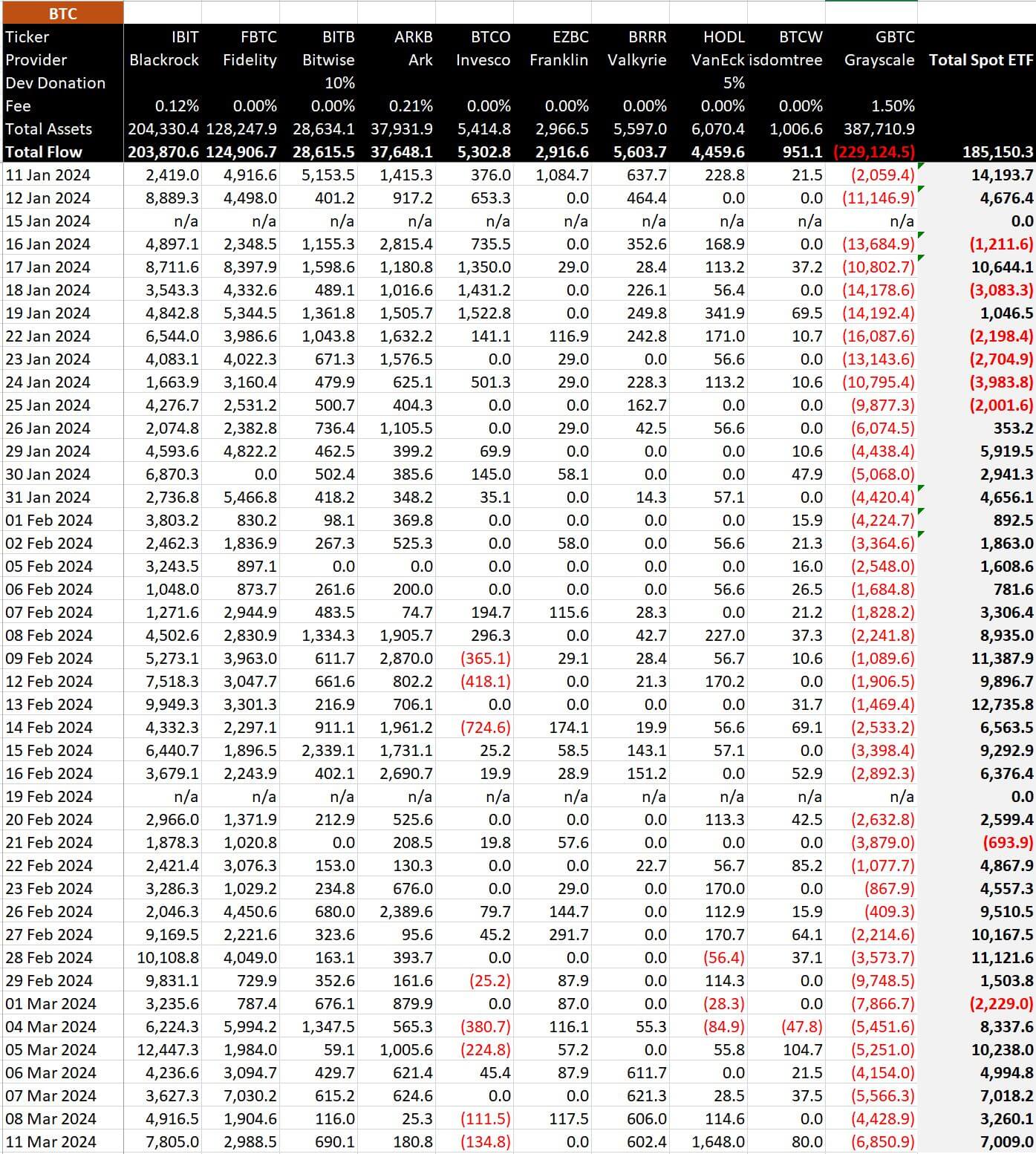
The strong performance of Bitcoin ETFs on March 11, 2024, affirms the growing interest in Bitcoin investments among institutional and retail investors alike.
The post Bitcoin ETFs see $505 million total inflows led by BlackRock as VanEck breaks record appeared first on CryptoSlate.
Report: Global Crypto Investments Surge to Record $2.7 Billion in Weekly Inflows
 In an unprecedented surge, global crypto investment products experienced a historic influx of $2.7 billion last week, signaling strong confidence among investors and propelling assets under management (AUM) back to December 2021 levels. Record $2.7 Billion Flows Into Crypto Investments in a Historic Week The record-breaking week saw digital asset investment vehicles garner inflows of […]
In an unprecedented surge, global crypto investment products experienced a historic influx of $2.7 billion last week, signaling strong confidence among investors and propelling assets under management (AUM) back to December 2021 levels. Record $2.7 Billion Flows Into Crypto Investments in a Historic Week The record-breaking week saw digital asset investment vehicles garner inflows of […]
Source link

Quick Take
According to Nate Geraci, President of the ETF Store, 2024 has marked a significant year for Bitcoin Exchange-Traded Funds (ETFs), particularly BlackRock IBIT and Fidelity FBTC. Geraci highlights these two Bitcoin ETFs as standing among the top 8 in terms of ETF inflows this year, a notable achievement considering the diverse ETF landscape.
CryptoSlate data on Feb. 21 reveals that IBIT has experienced net inflows totaling $5.5 billion, while FBTC has witnessed net inflows of $3.7 billion. These impressive numbers are in the company of inflows seen by three S&P 500 ETFs (VOO, IVV, & SPLG), the QQQ, Vanguard Total Stock Market ETF (VTI), and the iShares S&P 500 Value ETF (IVE), according to Geraci.
The success of IBIT and FBTC is further demonstrated by the combined net inflow of all spot US Bitcoin ETFs surpassing the $5 billion inflow benchmark. However, it is vital to quantify this success in a broader context. The aggregated investment across all Bitcoin US ETFs is estimated at around $41 billion.
Their success highlights the growing acceptance of Bitcoin as an asset and the potential future of ETFs in the digital asset space.
The post Two Bitcoin spot ETFs rank among top 8 for ETF inflows in 2024 appeared first on CryptoSlate.
Crypto Funds See Record $2.45 Billion Global Inflows in a Single Week: Coinshares
 In an unprecedented surge, crypto funds around the globe registered record inflows totaling $2.45 billion last week, marking a significant uptick in investor interest. This influx has propelled the total assets under management (AUM) back to levels not seen since December 2021, signaling a strong resurgence in the crypto investment space. Record $2.45 Billion Inflows […]
In an unprecedented surge, crypto funds around the globe registered record inflows totaling $2.45 billion last week, marking a significant uptick in investor interest. This influx has propelled the total assets under management (AUM) back to levels not seen since December 2021, signaling a strong resurgence in the crypto investment space. Record $2.45 Billion Inflows […]
Source link
February’s Bitcoin ETP net inflows close to total of previous three months
Quick Take
ByteTree has reported a massive influx in the global allocation of Bitcoin among exchange-traded products (ETPs) since October 2023, adding roughly 100,000 BTC.
According to ByteTree data, approximately 890,000 BTC are currently held in varying ETPs worldwide, which is about 4.56% of the circulating supply of Bitcoin. Interestingly, the start of 2024 has seen an increase of about 80,000 BTC in the ETP space, primarily attributed to US-based Bitcoin ETFs.
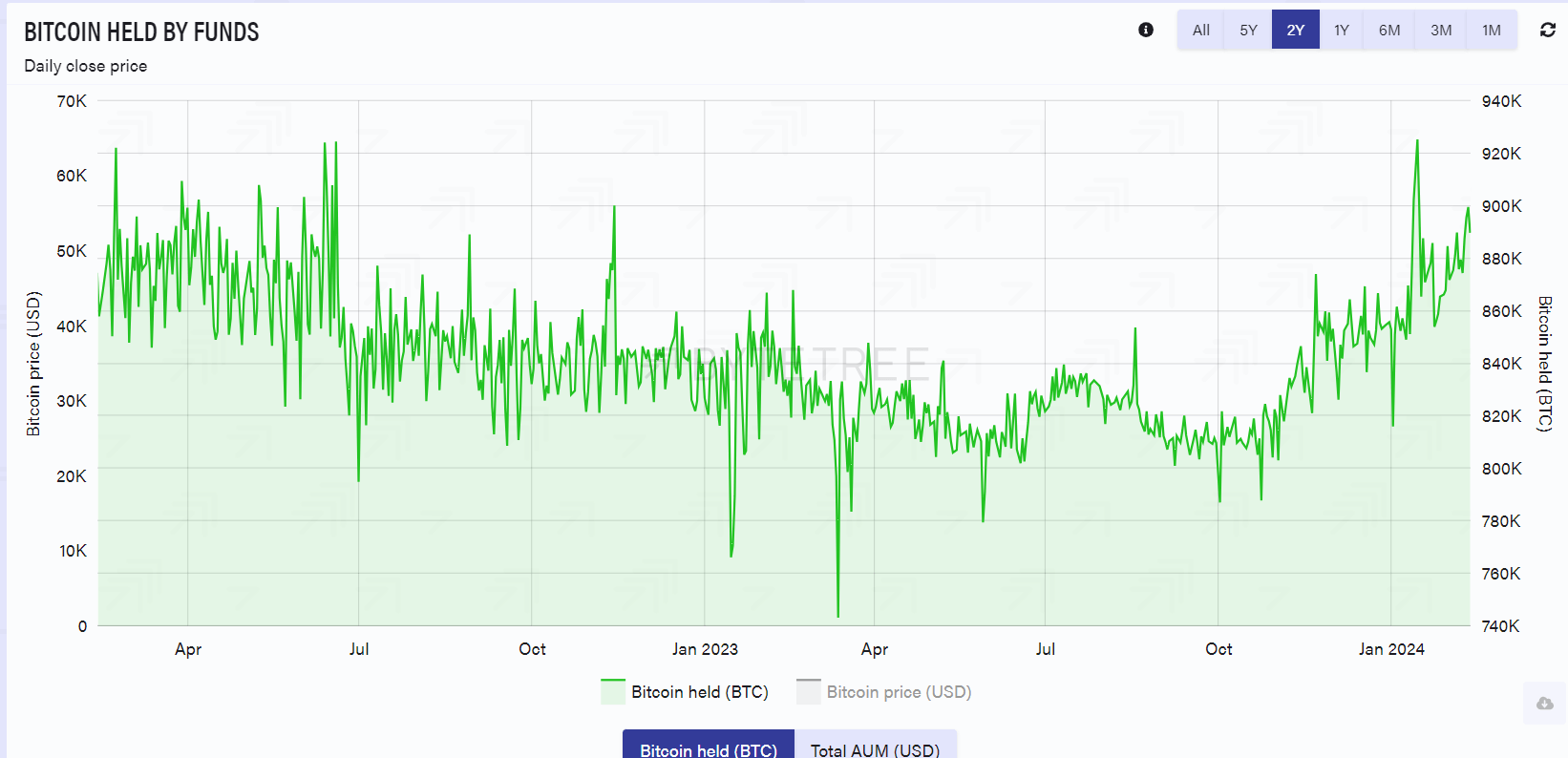
Within the last seven days alone, global Bitcoin ETPs underwent an influx of roughly 25,000 BTC, marking the most significant weekly increase since the early part of 2021.
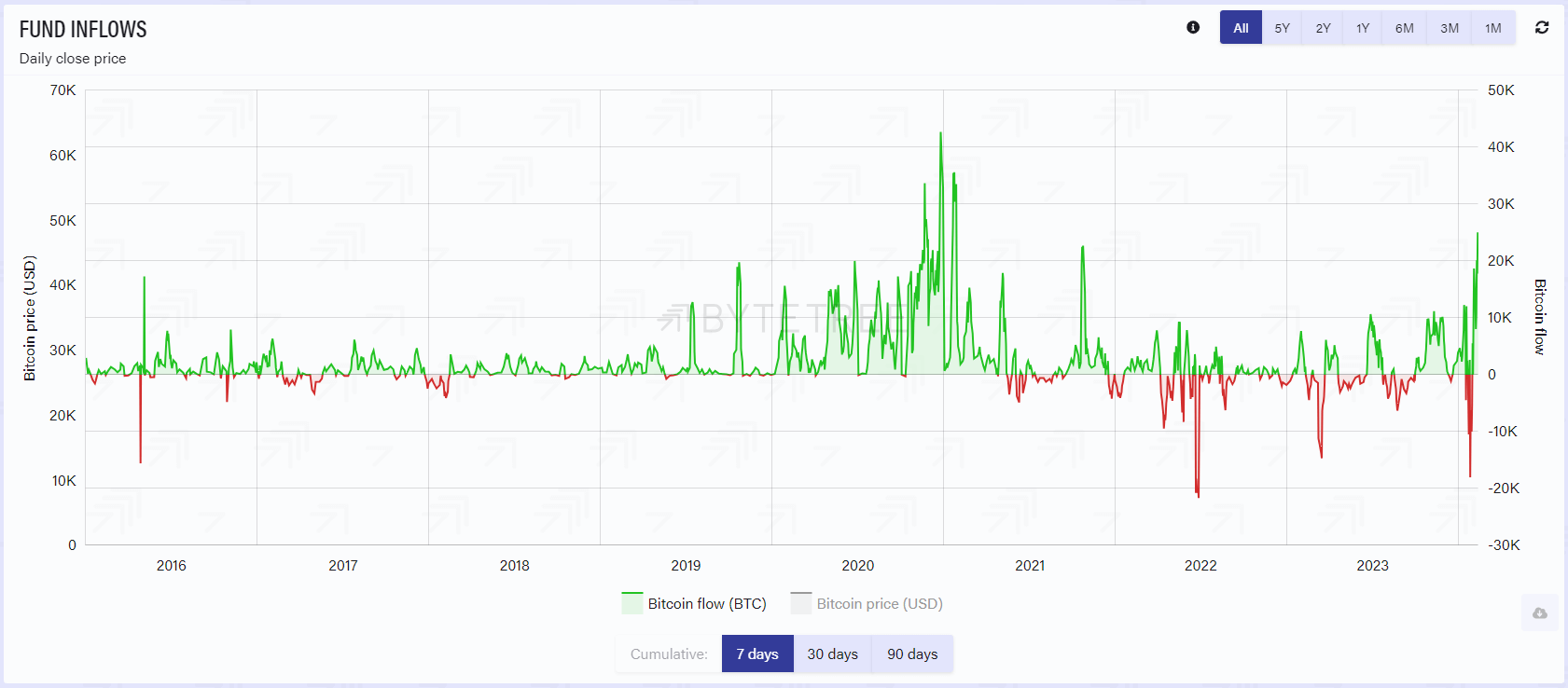
February alone contributed an impressive 38,000 BTC net inflow into ETPs, roughly equal to the combined flow for November, December, and January.

Glassnode data reports that Grayscale Bitcoin Trust (GBTC) currently holds approximately 466,000 Bitcoin, a significant 30% decline from its peak holdings of about 622,000 Bitcoin before Bitcoin ETFs began trading.
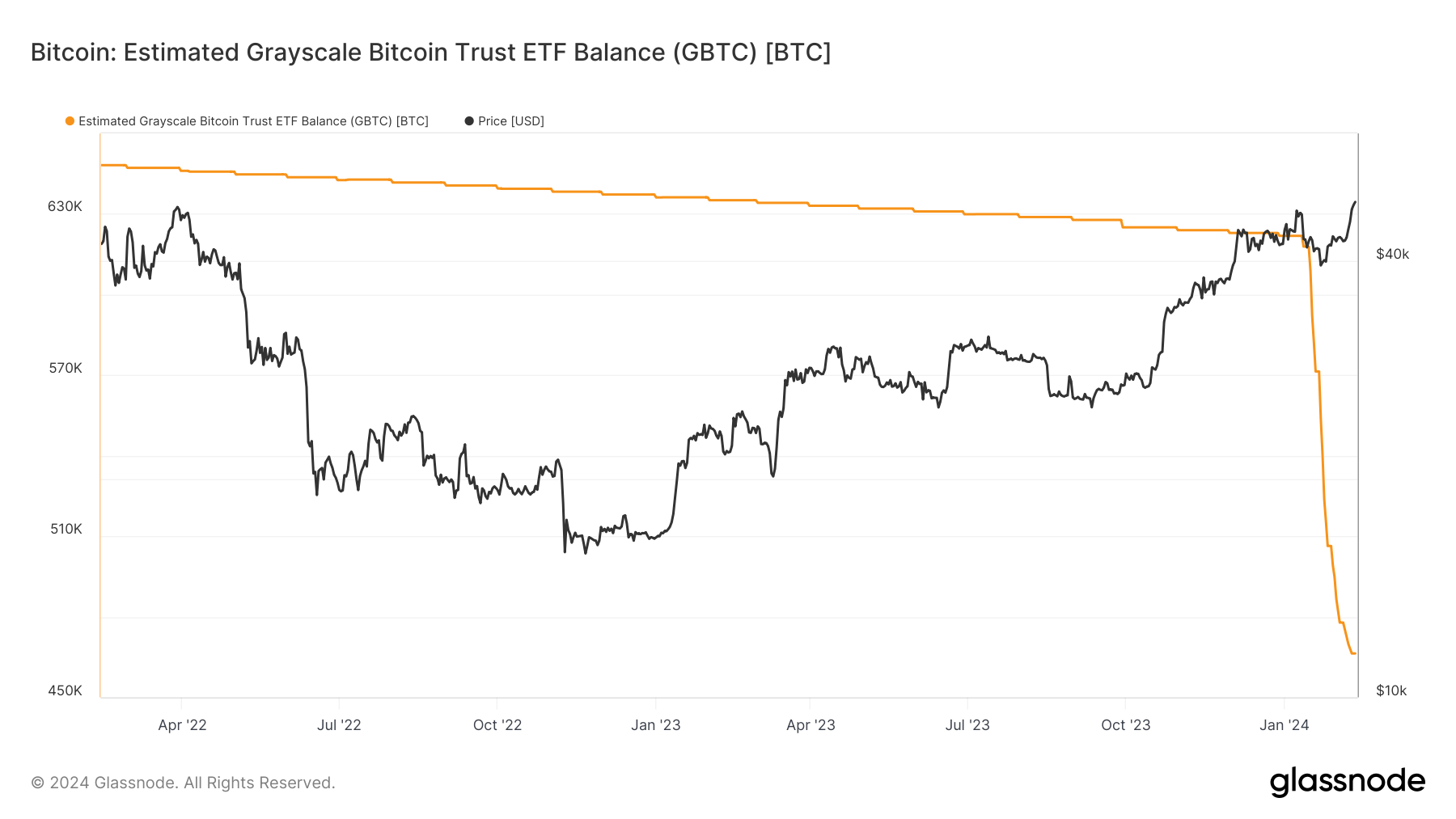
The post February’s Bitcoin ETP net inflows close to total of previous three months appeared first on CryptoSlate.
Two Bitcoin funds hit top 10 ETF inflows across all categories in January
Quick Take
January ETF flows demonstrated a new trend in the investment landscape. Although the iShares Core S&P 500 ETF ($11.8 billion) and the Vanguard S&P 500 ETF ($9.9 billion) led the month, two Bitcoin-focused ETFs carved out a notable place on the leaderboard, according to Geraci.
Despite having a fraction of the net assets, the iShares Bitcoin Trust ETF (IBIT) and the Fidelity Wise Origin Bitcoin ETF (FBTC) had an impressive $2.6 billion and $2.2 billion in net assets, respectively, according to Geraci. In comparison, Vanguard’s Total Stock Mkt ETF (VTI) recorded only marginally higher inflows at $2.7 billion.
This demonstrates a burgeoning investor interest in incorporating Bitcoin into their portfolios, even amid a decline in Bitcoin’s price from $49,000 to approximately $39,000 within the month.
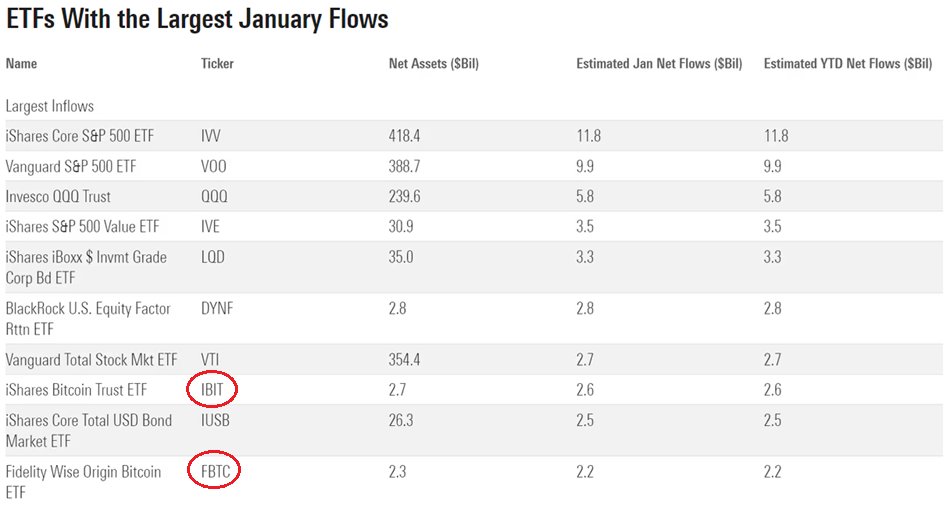
Considering the fact that there were around 3,109 ETFs active in the United States as of December 2023, according to Y Charts, the notable performance of these two Bitcoin ETFs is a significant indication of the evolving investment trends.
While the market dominance of traditional equity ETFs remains unchallenged, the impressive debut of Bitcoin ETFs suggests a steady acceptance of digital assets in the mainstream finance sector, marking a new phase in the digital asset investment era. At the same time, the digital assets industry is waiting on potential approval from the SEC on an Ethereum ETF.
The post Two Bitcoin funds hit top 10 ETF inflows across all categories in January appeared first on CryptoSlate.
The cryptocurrency industry has witnessed a significant change in the movement of stablecoins, offering valuable observations into the evolving dynamics of the market. Recent data from IntoTheBlock and CryptoQuant has shown a surge in stablecoin inflows into exchanges, reaching record highs in January.
Notable inflows were observed on January 2nd ($478 million), January 3rd ($489 million), and January 26th ($673 million). However, this trend has since reversed, with outflows dominating the market.
On January 30th, there was a substantial outflow of $412 million, marking the second-highest daily outflow recorded in the month, following the $541 million outflow on January 19th.
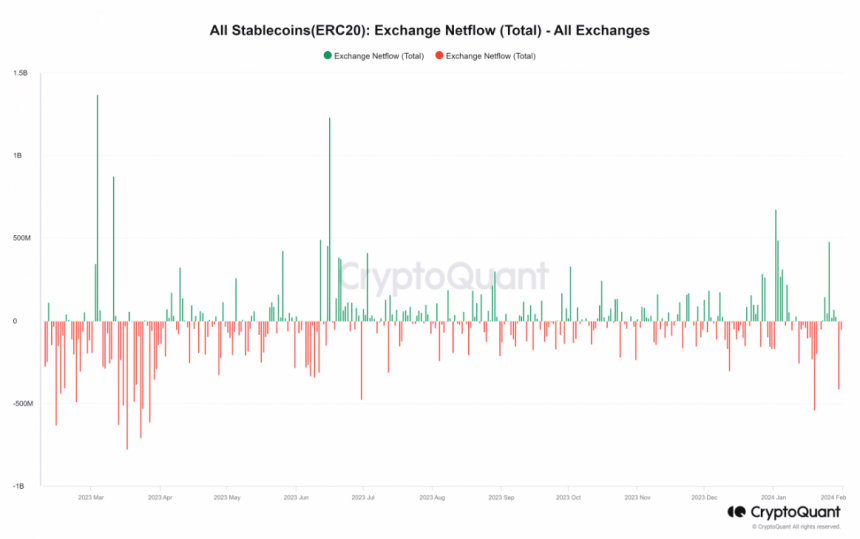
USDT Leads Stablecoin Rally, But Caution Persists In Crypto Market
An analysis of the 24-hour trading volume of the top stablecoins on CoinMarketCap reveals that Tether (USDT) and USD Coin (USDC) collectively accounted for approximately 90% of the total volume. Tether, in particular, has been dominant in terms of flows, with a 24-hour trading volume exceeding $42 billion, while USDC’s volume stood at around $6 billion.
Taking a closer look at the flow of USDT through CryptoQuant, it was found that there was a substantial inflow of $373 million on January 26th, followed by a prevailing trend of outflows, with over $83.4 million observed at the time of writing.
USDTUSD currently trading at $0.99897 on the daily chart: TradingView.com
Experts suggest that the rise in stablecoin inflows onto exchanges, particularly the $478 million on January 2nd, could indicate traders’ and investors’ readiness to participate in the market or their desire to safeguard their funds during uncertain times.
Conversely, the shift towards outflows may signal caution or preparation for potential market volatility. Additionally, the substantial inflow of stablecoins, especially USDT, could indicate increased buying power and intentions to establish positions in the cryptocurrency space.
Stablecoins Surge, Signal Investor Preparation
The increase in stablecoin inflows onto exchanges can be interpreted in two ways. Firstly, it may indicate that investors and traders are preparing to enter the market. By moving their funds into stablecoins, they can quickly transition into other cryptocurrencies when they perceive favorable opportunities. This suggests a readiness to participate and take advantage of potential market movements.
Secondly, the rise in stablecoin inflows may also reflect a desire to keep funds in a secure manner, particularly during uncertain times. Stablecoins offer stability by being pegged to a specific asset, such as the US dollar, which can be appealing to investors seeking to protect their capital in times of market volatility. This cautious approach can be seen as a way to safeguard funds and mitigate risks in an unpredictable market.
Tether Records Nearly $3 Billion Profit
Meanwhile, Tether announced a “record-breaking” $2.85 billion in quarterly profits as the market capitalization of its main token, USDT, approached $100 billion.
According to a blog post by Tether, the interest gained on the company’s enormous holdings in US Treasury, reverse repo, and money market funds—which support the USDT stablecoin—account for around $1 billion of the earnings in the most recent quarterly attestation report that was released on Wednesday. Everything else was “mainly” due to the growth of Tether’s other assets, like gold and bitcoin (BTC), the stablecoin issuer said.
Featured image from Wccftech, chart from TradingView
Disclaimer: The article is provided for educational purposes only. It does not represent the opinions of NewsBTC on whether to buy, sell or hold any investments and naturally investing carries risks. You are advised to conduct your own research before making any investment decisions. Use information provided on this website entirely at your own risk.
Fidelity inflows smash Grayscale outflows as $255 million Bitcoin enters US market
Grayscale’s Bitcoin Trust (GBTC) is experiencing a slowdown in outflows, with just under $200 million withdrawn from the fund on Jan. 29.
Data from BitMEX Research indicates a total outflow of around $192 million during this reporting period. Notably, this marks the lowest outflows since the fund’s inception, surpassing only the initial day of trading when withdrawals amounted to $95 million.
Meanwhile, a look at the newborn nine shows that the inflows into the funds keep offsetting that of Grayscale.
The Fidelity Wise Origin Bitcoin Fund (FBTC) emerged as a standout, concluding the twelfth trading day with the highest inflow at $208 million. In comparison, other funds, including BlackRock’s IBIT, experienced a $198 million inflow. ETFs such as BITB, ARKB, and BTCO recorded inflows of $20 million, $17 million, and $3 million, respectively, while others reported zero inflows.
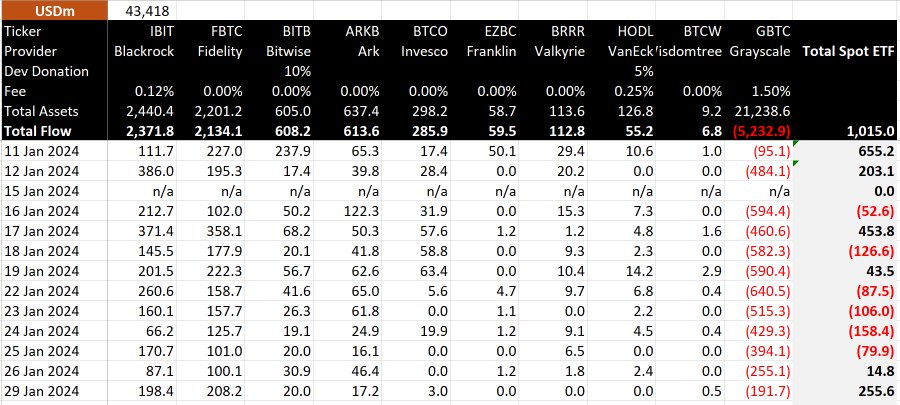
The robust trading activities contributed a net inflow of $255.6 million during the twelfth trading day.
GBTC maintains ‘liquidity crown’
However, Grayscale’s GBTC remains the top cryptocurrency ETF in liquidity, as Bloomberg Intelligence analyst James Seyffart observed.
Despite recent outflows, GBTC’s trading volume reached $570 million on Jan. 29, surpassing BlackRock’s IBIT by $110 million and reaffirming its market dominance.
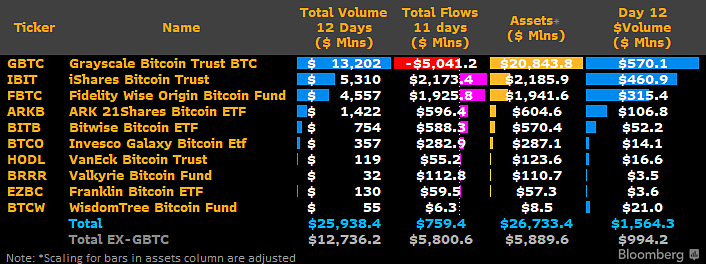
Following its recent conversion, Grayscale’s ETF has experienced substantial outflows totaling more than $5 billion. Analysts attribute the outflows to profit-taking maneuvers by investors exposed to its previous net asset value discount.
Furthermore, the fund’s relatively high 1.5% management fee is cited as a factor that has led some investors to shift towards competing ETF providers such as BlackRock and Fidelity, who charge a lower fee of 0.25%.
As of Jan. 29, the outflows have resulted in Grayscale’s ETF’s Assets Under Management (AUM) dropping to approximately $21.431 billion (equivalent to 496,573 BTC) from its year-to-date peak of nearly $29 billion (623,390 BTC), as reported by the fund’s official website. This data indicates that fund users have divested over 100,000 units of the leading cryptocurrency since the approval of the ETF conversion.
Digital asset ETPs record $2.2 billion inflows for 2023, market eyes spot Bitcoin ETF launch

What is CryptoSlate Alpha?
A web3 membership designed to empower you with cutting-edge insights and knowledge. Learn more ›
Connected to Alpha
Welcome! 👋 You are connected to CryptoSlate Alpha. To manage your wallet connection, click the button below.
Oops…you must lock a minimum of 20,000 ACS
If you don’t have enough, buy ACS on the following exchanges:
Connect via Access Protocol
Access Protocol is a web3 monetization paywall. When users stake ACS, they can access paywalled content. Learn more ›
Disclaimer: By choosing to lock your ACS tokens with CryptoSlate, you accept and recognize that you will be bound by the terms and conditions of your third-party digital wallet provider, as well as any applicable terms and conditions of the Access Foundation. CryptoSlate shall have no responsibility or liability with regard to the provision, access, use, locking, security, integrity, value, or legal status of your ACS Tokens or your digital wallet, including any losses associated with your ACS tokens. It is solely your responsibility to assume the risks associated with locking your ACS tokens with CryptoSlate. For more information, visit our terms page.






